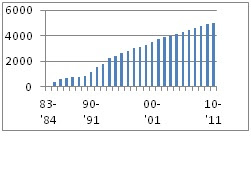Agglomeration in Dhaka: How does Read Made Garment (RMG) industry make Dhaka the fastest growing city of the world?
by Md Masud Karim
In
a sunny day of last summer, I was shopping with my German friend in one outlet
of H&M in Budapest and suddenly she shouted “Oh My God! This T-shirt is too
cheap! Masud, you see it is from your country”.
There is no doubt that the magical role of Ready Made Garment (RMG)
industry in the agglomeration of Dhaka, the capital of Bangladesh, is more
surprising.
Between
1990 to 2005, Dhaka, the fastest growing city on the earth, doubled in number-
from 6 million to 12 million. According to United Nations, Dhaka which is the
residence of 17 million people by 2011 will be the home of more than 20 million
by 2025. It is well known that massive migration, high birth rate and new
experience of free international trade are swelling cities in developing world;
however, these factors are perhaps more strongly intense in Dhaka than anyplace
in the world. Thanks to the concentrations of export oriented textile industry
in Dhaka, which starts in 1980s and flourished in last thirty years, and thus
created this massive agglomeration.
The
RMG sector of Bangladesh has experienced a dramatic growth in last three decades.
At present, Bangladesh ranks the third largest garment exporter after China and
Turkey in the world. Before 1980, the country’s RMG industry’s role was mainly
import substitution; hence, was not subject to export limit under the
Multi-Fiber Arrangement (MFA). This opportunity did not escape the attention of
Daewoo Corporations of South Korea, one of the largest RMG manufacturers losing
from quota system. Without making delay, Daewoo teamed up with a Dhaka based new
enterprise Desh Ltd. in 1979.
Knowledge and technological
spillovers seems to be the first cause of RMG industry development in Dhaka. In 1979, Desh sent 130
new employees to Daewoo’s factory in South Korea, where they took part in an
eight-month intensive training course on garments industry. Within few years,
like employees of Silicon Valley companies who started their own business, most
of these employees had left Desh and started their independent RMG business in
Gazipur and Mirpur area of Dhaka. In retrospect, even though it was a great
blow to Desh and Daweoo, it was boon for Bangladesh. In 1980, number of RMG
factory was 47 which increased to 804 by 1990 and 5000 by 2011.
The
contribution of government in the sustainable development of this sector is
beyond question. In 1985, special benefit under MFA was withdrawn; however, the
growth of RMG was thriving. At present, this sector accounts for 75% of countryexport and 25% of GDP.
Figure: Number of garments factories
in Bangladesh
Figure: Employment (million
workers)
Source: Bangladesh Garments Manufacturers and Exporters Association
Perhaps
no other industry in the world contributed in agglomeration of a city like RMG
has done to Dhaka city. As majority of RMG factories are set up in Dhaka city,
it attracted unskilled and semi skilled labor from the whole country. At
present this sector employs 3.6 million people of which 85% are woman.
This sector has created job
opportunity not only for unskilled and semi-skilled but also for university
graduates. Nowadays many universities in Dhaka city offer degree on textile.
This makes it easier for the industry to recruit employees and at the same time
employees have choice whom to work for.
The concentration of the RMG industry
in Dhaka has also induced the growth of other related business with close
proximity to the RMG factories. Importers of raw materials and agent offices of
foreign buyers find it advantageous to be close to production units.
Consequently, it increases efficiency of this industry.
In
comparison to other cities in Bangladesh, Dhaka
has the largest high and middle income consumer base. Moreover, people in
Bangladesh have a tendency to travel to the capital for shopping which also
makes Dhaka more important local market. Even if foreign buyers cancel orders,
garments owners still can have sound sleep as they know these garments can be
sold in clothing markets of Dhaka like hot cake.
In the long run, garments industry
in Dhaka likely to be hurt by high labor cost pushed by high living expenses,
labor unrest which has become a common phenomenon; however, the wave of
agglomeration this industry has created seems to be long-lasting. At present,
out of 87 universities in the country, Dhaka city, which is one of 64 cities in
Bangladesh, is the home of 52 universities. Moreover, the presence of all the
urban amenities such as healthcare, theaters, and stadiums are also biased
toward Dhaka. These factors will
continue to attract rich, educated people of the country, who are willing to
pay extra living expenses to enjoy urban amenities.















2 comments:
A successful business sets goals of success, in order to have a solid idea of what it’s working towards. Set a goal and believe in your ability to reach it. As the law of attraction goes: if you know you’re gonna reach it, you’re gonna reach it View it.
every businessman have one goal to make there customer satisfied totally
http://www.4aryansoftware.com/
Post a Comment